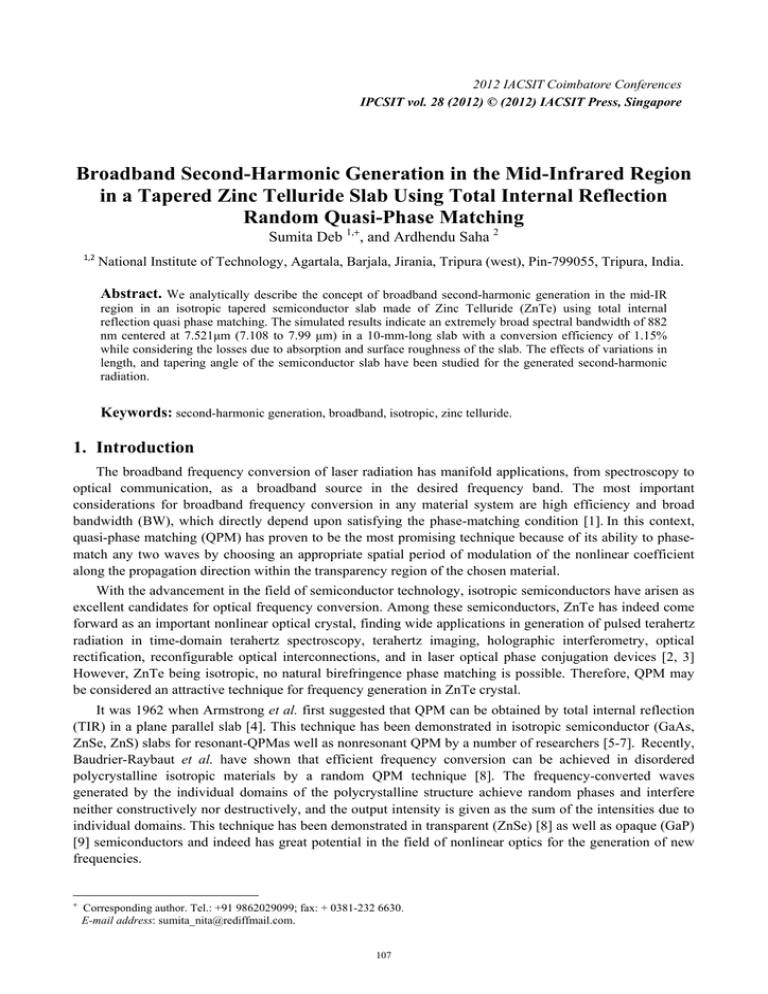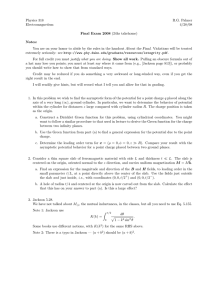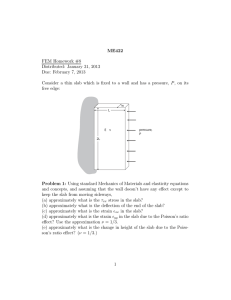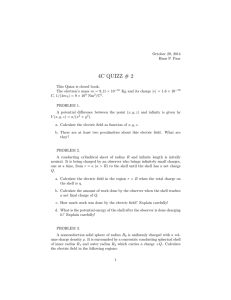Broadband Second-Harmonic Generation in the Mid-Infrared Region
advertisement

2012 IACSIT Coimbatore Conferences
IPCSIT vol. 28 (2012) © (2012) IACSIT Press, Singapore
Broadband Second-Harmonic Generation in the Mid-Infrared Region
in a Tapered Zinc Telluride Slab Using Total Internal Reflection
Random Quasi-Phase Matching
Sumita Deb 1,+, and Ardhendu Saha 2
1,2
National Institute of Technology, Agartala, Barjala, Jirania, Tripura (west), Pin-799055, Tripura, India.
Abstract. We analytically describe the concept of broadband second-harmonic generation in the mid-IR
region in an isotropic tapered semiconductor slab made of Zinc Telluride (ZnTe) using total internal
reflection quasi phase matching. The simulated results indicate an extremely broad spectral bandwidth of 882
nm centered at 7.521μm (7.108 to 7.99 μm) in a 10-mm-long slab with a conversion efficiency of 1.15%
while considering the losses due to absorption and surface roughness of the slab. The effects of variations in
length, and tapering angle of the semiconductor slab have been studied for the generated second-harmonic
radiation.
Keywords: second-harmonic generation, broadband, isotropic, zinc telluride.
1. Introduction
The broadband frequency conversion of laser radiation has manifold applications, from spectroscopy to
optical communication, as a broadband source in the desired frequency band. The most important
considerations for broadband frequency conversion in any material system are high efficiency and broad
bandwidth (BW), which directly depend upon satisfying the phase-matching condition [1]. In this context,
quasi-phase matching (QPM) has proven to be the most promising technique because of its ability to phasematch any two waves by choosing an appropriate spatial period of modulation of the nonlinear coefficient
along the propagation direction within the transparency region of the chosen material.
With the advancement in the field of semiconductor technology, isotropic semiconductors have arisen as
excellent candidates for optical frequency conversion. Among these semiconductors, ZnTe has indeed come
forward as an important nonlinear optical crystal, finding wide applications in generation of pulsed terahertz
radiation in time-domain terahertz spectroscopy, terahertz imaging, holographic interferometry, optical
rectification, reconfigurable optical interconnections, and in laser optical phase conjugation devices [2, 3]
However, ZnTe being isotropic, no natural birefringence phase matching is possible. Therefore, QPM may
be considered an attractive technique for frequency generation in ZnTe crystal.
It was 1962 when Armstrong et al. first suggested that QPM can be obtained by total internal reflection
(TIR) in a plane parallel slab [4]. This technique has been demonstrated in isotropic semiconductor (GaAs,
ZnSe, ZnS) slabs for resonant-QPMas well as nonresonant QPM by a number of researchers [5-7]. Recently,
Baudrier-Raybaut et al. have shown that efficient frequency conversion can be achieved in disordered
polycrystalline isotropic materials by a random QPM technique [8]. The frequency-converted waves
generated by the individual domains of the polycrystalline structure achieve random phases and interfere
neither constructively nor destructively, and the output intensity is given as the sum of the intensities due to
individual domains. This technique has been demonstrated in transparent (ZnSe) [8] as well as opaque (GaP)
[9] semiconductors and indeed has great potential in the field of nonlinear optics for the generation of new
frequencies.
+
Corresponding author. Tel.: +91 9862029099; fax: + 0381-232 6630.
E-mail address: sumita_nita@rediffmail.com.
107
2. Proposed Scheme
We have considered a tapered semiconductor slab (Fig. 1) of length, L, with the base surface parallel to
the horizontal plane while the upper surface is tapered at an angle θ determined by the heights of the two
ends t1 and t2, t1< t2. The face on which the fundamental laser radiation will be incident is cut at an angle ψ
with respect to a plane perpendicular to the horizontal plane.
Fig. 1. Geometry of tapered semiconductor slab showing the scheme of second harmonic frequency conversion.
Let the fundamental broadband optical radiation having centre frequency ω1 be incident at an angle φi
with respect to the normal to the inclined slab end face. The angle of incidence φ1 on the horizontal plane
inside the semiconductor slab will be determined by the refractive index of the material. If φ1 is greater than
the critical angle for the range of input frequencies, then the collimated optical radiation will undergo TIR
inside the tapered slab. Here the angle of incidence and the length between successive bounces will continue
to increase with the propagation of the input broadband radiation throughout the length of the tapered
semiconductor slab. This scheme corresponds to non-resonant QPM since the interaction lengths between
successive bounces cannot be optimized to be equal to an odd multiple of the coherence length Lcoh (=π/∆k,
where ∆k is the dispersive wave-vector mismatch) for all the frequencies available in the input band of the
fundamental laser radiation. However, a situation may arise wherein one length may coincide with an odd
multiple of the coherence length of a particular frequency in the input band of the fundamental waves,
whereas another length may coincide with an odd multiple of the coherence length of another frequency in
the band, and so forth. The conversion efficiency for that particular frequency will be higher for that
particular interaction length since it will then correspond to resonant QPM. However, the conversion
efficiencies of other frequencies will be lower for that interaction length owing to non-resonant QPM. The
phase shifts of the interacting waves indeed vary randomly during their propagation inside the slab, thereby
giving rise to a situation identical to that of random QPM, wherein the constructive as well as the destructive
interference effects of the interacting waves are destroyed. Clearly, the proposed scheme is less efficient than
the truly phase-matched condition because the latter benefits from the constructive interference of the waves
generated by different parts of the nonlinear medium, but it outperforms the phase-matched scenario for
which the interference of the generated waves is destructive, thereby resulting in a flatter spectral BW.
2.1. Mathematical Analysis
Now, in this tapered slab configuration with simple geometry the equation for the length between
consecutive bounces can be expressed in terms of slab parameters as follows:
L1 = xcosψ/[sin(φr+ψ)]
(1)
where L1 is the length between the entrance point and the point of first TIR point inside the slab, x is the
slant distance of the entrance point from the base of the slab, and φr = sin-1[(sinφi)/nk],
where nk is the refractive index corresponding to each individual frequency of the input broadband laser
radiation.
The distance between successive bounces can be expressed by the following coupled equations:
l2 = xsinψ + (xcosψ tanφ1) + t1tanφ1 - t1tanψ
z'2n-1 = (l2n-2sinθ)/cosφ2n-2, n = 2, 3...ntot
'
l2n = l2n-2 + z 2n-1sinφ2n-3 + [(z'2n-1sinφ2n-3)/tan(π/2 - φ2n-1)] + 2t1tanφ2n-1, n= 2, 3...ntot
108
z'2n+1 = (l2nsinθ)/cosφ2n, n = 1, 2, 3...ntot
L2n = (t1/cos φ2n-1) + [(l2nsinθ)/cosφ2n], n = 1, 2, 3...ntot
L2n+1 = (t1/cos φ2n+1) + [(z'2n+1 cos2n-1)/cosφ2n+1), n = 1, 2, 3...ntot
Here,
θ = tan-1[(t1-t2)/L]
φn = (n-1)θ + φ1, n = 1, 2, 3...ntot,
where φ1 = π/2 – (φr+ ψ ) and ntot is the total number of bounces inside the tapered slab.
(2)
(3)
(4)
(5)
2.2. Polarization Configuration
In our analysis we consider the ppp polarisation configuration. ZnTe belongs to symmetry class 43m.
We have used the approximate value of d14=90 pm/V for ZnTe crystal [l0].
2.3. Conversion Yield Limiting Factors
The SHG conversion efficiency is limited by three important factors: the surface roughness, the GoosHänchen shift, and the absorption loss of the material. All these factors are considered in our analysis.
The drop due to residual surface roughness is measured in terms of the Strehl ratio [7, 11], which gives
the reflection coefficient, R as a function of wavelength, angle of incidence, and standard deviation,
(6)
R = exp[-{(4πnjσcosφn)/λj}2] ≈ 1- {(4πnjσcosφn)/λj}2
where j = ω for the fundamental wave and 2ω for the generated SH, and σ(= p v value/12) [12] where the p
v value is the distance between the peak and valley of the surface under consideration. A p v value of 30
nm is considered in the computer-aided simulation [13].
When a collimated light beam is totally reflected from a plane interface between two dielectric media,
the reflected beam encounters a longitudinal shift between the incident and reflected beams known as the
Goos-Hänchen (GH) shift) [14]. This longitudinal shift causes a reduction of the usable length of the
semiconductor slab. In our case, the GH shift has been separately calculated for the lower horizontal surface
and the inclined upper surface.
Linear absorption can be highly detrimental to frequency conversion processes and places severe limits
on conversion efficiency values. In our analysis we consider a linear absorption coefficient (αω≈ α2ω)
0.008cm-1 for ZnTe crystal [10].
2.4. SH Intensity
The SHG intensity I2ω for the undepleted pump and plane wave approximation is calculated individually
for each interaction length using the relation
I2ω={(8π2deffL2Iω2)/(εocn2ωnω2λω2)}exp[{αω+(α2ω/2)}L][sin2(ΔkL/2)+sinh2{αω-(α2ω/2)}L/2]/[(ΔkL/2)2+{αω(α2ω/2)}L/2}2] ,
(7)
All these values of I2ω are summed to obtain the final output intensity for a particular wavelength. In
our analysis the interaction length between the last bounce and the exit point from the semiconductor slab is
not considered. The effects of linear absorption and surface roughness on both the fundamental and the
generated SH waves are included for all the consecutive bounces inside the slab. The reduction in the usable
length of the semiconductor slab due to the GH shift is also considered in the analysis. The dispersion
equation of ZnTe [15], has been used to calculate the refractive indices corresponding to fundamental and
SH for the range of frequencies available in the input broadband source.
3. Results and Discussions
In the computer-aided simulation, the input beam intensity is assumed to be Iω ≈ 10 MW/cm2. The
analysis uses an input fundamental broadband source of 6.8−8.2 μm. The slab dimensions are set asL = 10
mm, t1 = 1000 μm, and t2 = 1010 μm. The input conditions at the entry point of the collimated optical beam
to the semiconductor slab are chosen as фi = 1.1 rad and x = 100 μm. The variation of SH efficiency with
respect to the input fundamental wavelength is shown in Fig. 2. The analytical results thus obtained indicate
the possibility of an extremely wide spectral BW of 887 nm in the tapered slab under ideal conditions,
neglecting all the losses. However, when the effects of the surface scattering, absorption, and GH shift of the
109
interacting waves
w
are taaken into acccount, the BW
W is reduced
d to 882 nm. The SH connversion efficciency dropss
by 16% relaative to its vaalue under noo-loss condittion.
Fig. 2. Plott of SH efficieency vs input wavelength
w
foor
the taperedd ZnTe slab forr ψ = 0.6 rad, фi= 1.1 rad, L
=10 mm, t1=
= 1000 μm, annd t2 =1010 μm
m: (a) under non
loss conddition and (b) considering all
a the losses
(scattering, absorption, GH
G shift) encoountered by thhe
interactting waves.
Fig.
F 3.Variatioon of net phasse shift encoun
ntered by the
interacting waves at eachh TIR bounce inside the
tapered slab corresponding
c
g to the centre wavelength
(7.5211μm) of the fuundamental beeam.
For the tapered slabb, since the lengths
l
betw
ween the conssecutive bouunces and alsso the angle of incidencee
at each bounnce change with
w the proggression of thhe collimated
d beam insidde the slab, thhe net phase shift at eachh
bounce is given as ∆ф = ∆kLi+∆фF, where Li is the interactio
on length beetween two cconsecutive bounces,
b
andd
p
shifts encounteredd at TIR by the SH andd
∆фF= фp2ω - фpω, wheree фp2ω and фpω denote the Fresnel phase
fundamentaal waves resspectively. This
T
value of
o ∆ф is rapidly varyinng (Fig. 3), thereby destroying thee
interferencee effect amonng the generrated waves.. This eventu
ually resultss in a flatter spectral resp
ponse at thee
cost of loweer conversionn efficiency.
We studdied the effeects of varyinng the tapering angle and
d slab lengthh on the geneerated SH effficiency andd
the fundameental bandwiidth for the tapered ZnTee slab under consideration
c
n.
3.1. Variiation of taapering anggle
The tappering angle θ of the slabb can be varied by chang
ging the seconnd height t2 (Fig.1) of th
he slab whilee
keeping thee first heighht t1 constannt at 1000 μm.
μ
With in
ncreasing (t2 – t1), θ inccreases, resu
ulting in thee
broadening of the 3 dB BW, with a drop in connversion efficciency. Wheen (t2 – t1) is increased frrom 10 to 300
W broadeningg is 67 nm, while the reelative drop in the peak conversion eefficiency is about 23%..
μm, the BW
The analyticcal results arre shown in Table
T
I.
Table I. Vaariation in perfformance paraameters with increase
i
in heiight t2 for L = 10 mm, фi= 1.1 rad, and t1=1000 μm.
t2-t1(μm)
SH connversion efficiency (%)
3 dB BW (nm
m)
10
20
30
1.15
1.05
0.996
882
894
949
3.2. Variiation of slaab length
With inncreasing cryystal length, the
t SH conveersion efficieency improvves but its BW
W shows slig
ght decrease..
Table II shoows the analyytical resultss for the variaation in leng
gth of the slabb. As the lenngth is increaased from 100
to 20 mm, the SH conveersion efficieency increasees relatively by
b 70% whille the BW drrops by only 12 nm.
Table II. Effe
fect of variatioon in performaance parameteers with slab leength L for Φi=
Φ 1.1 rad, t1=
=1000 μm, an
nd t2=1010μm
m.
Slaab length L (m
mm)
10
15
20
SH connversion efficiency (%)
1.15
1.612
1.96
110
3 dB BW (nnm)
882
874
870
4. Conclusion
To conclude in this paper, a broadband frequency converter based on a tapered ZnTe slab has been
analysed numerically. The converter provides an extremely wide 3 dB BW of 882 nm (approximately 7.108
to 7.99 μm), centred at 7.521 μm, in the mid-IR region, with a SH conversion efficiency of 1.15 %, while
considering the losses. The proposed frequency converter may be considered as a simple yet competitive
means of obtaining extremely wide broadband SHG based on ZnTe isotropic crystal.
5. References
[1] M. M. Fejer, G. A. Magel, D. H. Jundt, and R. L. Byer, Quasi-Phase-Matched Second Harmonic Generation:
Tuning and Tolerances. IEEE J. Quantum Electron. 1992, 28: 2631-2654.
[2] S. M. Harrel, R. L. Milot, J. M. Schleicher, and C. A. Schmuttenmaerc, Influence of free-carrier absorption on
terahertz generation from ZnTe (110). J. Appl. Phys. 2010, 107: 033526-1- 033526-5.
[3] http://en.wikipedia.org/wiki/ZnTe
[4] J. A. Armstrong, N. Bloembergen, J. Ducuing, and P. S. Pershan, Interactions between light waves in a nonlinear
dielectric. Phys. Rev. 1962, 127: 1918-1939.
[5] G. D. Boyd and C. K. N. Patel, Enhancement of optical second harmonic generation (SHG) by reflection phasematching in ZnS and GaAs. Appl. Phys. Lett. 1966, 8: 313-315.
[6] H. Komine, W. H. Long, Jr., J. W. Tully, and E. A. Stappaerts, Quasi-phase-matched second-harmonic generation
by use of a total-internal-reflection phase shift in gallium arsenide and zinc selenide plates. Opt. Lett. 1998, 23:
661-663.
[7] R. Haıdar, N. Forget, P. Kupecek, and E. Rosencher, Fresnel phase matching for three-wave mixing in isotropic
semiconductors. J. Opt. Soc. Am. B. 2004, 21: 1522-1534.
[8] M. Baudrier-Raybaut, R. Haıdar, Ph. Kupecek, Ph. Lemasson, and E. Rosencher, Random quasi-phase-matching
in bulk polycrystalline isotropic nonlinear materials. Nature. 2004, 432: 374-376.
[9] V.A. Mel’nikov, L.A. Golovan, S.O. Konorov, D.A. Muzychenko, A.B. Fedotov, A.M. Zheltikov, V.Yu.
Timoshenko, and P.K. Kashkarov: Second-harmonic generation in strongly scattering porous gallium phosphide
Appl. Phys. B. 2004, 79: 225-228.
[10] http://www.clevelandcrystals.com/II-VI.htm
[11] P. K. Tien, Light waves in thin films and integrated optics Appl. Opt. 1971, 10: 2395-2413.
[12] R. Haıdar, P. Kupecek, E. Rosencher, R. Triboulet, and P. Lemasson, New mid-infrared optical sources based on
isotropic semiconductors (zinc selenide and gallium arsenide) using total internal reflection quasi-phase-matching.
Opto-Electron. Rev. 2003, 11: 155-160.
[13] N. Lovergine, D. Manno, A. M. Mancini, and L. Vasanelli, Surface structural and morphological characterization
of ZnTe epilayers grown on {100} GaAs by MOVPE. J. Cryst. Growth. 1993, 128: 633-638.
[14] A. W. Snyder and J. D. Love, Goos-Hänchen shift. Appl. Opt. 1976, 15: 236-238.
[15] D. T. F. Marple, Refractive index of ZnSe, ZnTe, and CdTe. J. Appl. Phys. 1964, 35: 539-542.
111







